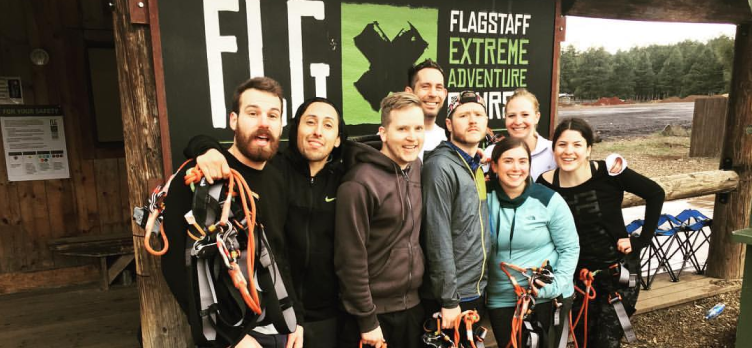advertisement
16 May 2022
If you’re an adrenaline junkie, the Flagstaff Extreme Adventure Course (FEAC) will be heaven for you. In Fort Tuthill County Park, FEAC has zip lines, suspended bridges, obstacles, and more, all zigzagging among the Flagstaff evergreens.
When you first arrive, you’ll get a crash course on safety, the ins and outs of the course you’ve signed up for, and you’ll be outfitted in a harness that fits your body size. The major takeaway from the safety course is you ALWAYS must have at least one of your two carabiners attached to the obstacles. If that means you are climbing a rope ladder, then, yep — one carabiner on, the next one attached to the rung above, and so on. It can slow you down, but it is essential for your safety while playing on the obstacle course, especially with obstacles as high as 80 feet.
advertisement

There are packages for different age groups as low as seven years old, but we did the Adventure Course for my group, which is about $58 per person. From the start, the course is pretty linear — you line up with your group and climb up and over different obstacles together one after the other. Pro-tip: try to line up from the most experienced/fastest climber to the slowest. It works best if a less experienced climber isn’t getting in the way of someone hot on their heels.
advertisement
The obstacle course ramps up from easy, to medium, to complex, to whoa, this is impossible, and I’m 80 feet off the ground 😱 . It can sometimes feel pretty scary and death-defying, even though you have no danger of falling — that’s what your harness is for! Nevertheless, your lizard brain can quickly forget about this safety measure, and you’ll find yourself gripping onto the ropes for dear life.
This place was one of the most fun outings I have had while living in Arizona. If you love adventure, adrenaline spiking, and hanging outdoors with adventure-loving friends, this is your place. Happy adventuring!
advertisement
Arizona is a hiker’s paradise, whether you’re a seasoned adventurer or a casual weekend explorer, the state has a trail for every style, season, and skill level. Here are some of the best places to hike in Arizona. advertisement 1. Cathedral Rock – Sedona Difficulty: Moderate to strenuous Why It’s Amazing: This iconic red-rock formation offers one of Sedona’s most breathtaking climbs. The trail is steep, hands-on, and rewarding with unforgettable panoramic views. 2. Camelback Mountain – Phoenix Difficulty: Strenuous Why It’s Amazing: One of the most famous urban hikes in the country, Camelback delivers challenging scrambles, busy energy, and
When most people picture Arizona, they imagine cactus-filled deserts and blazing summer heat. But head north or climb in elevation, and a completely different side of the state appears: powdery snow, pine forests, cozy cabins, and ski runs with sweeping mountain views. Arizona’s snowy adventures offer a surprising winter escape for travelers who want chill instead of sizzle. advertisement Where to Find Snow in Arizona Snow in Arizona is all about elevation. The higher the climb, the better the chance of a winter wonderland. Northern and eastern Arizona are the prime regions for cold-weather fun, with pine-covered plateaus and mountain
Arizona, with its impressive diversity, surprises newcomers and constantly defies stereotypes. While many people picture endless deserts, triple-digit temperatures, and sunburn as far as the eye can see, the reality is far more varied. Here are the top 10 misconceptions about Arizona, and the truth behind them. advertisement 1. Arizona Is Just a Hot, Dry Desert Most people imagine the entire state melting under 115°F heat. And while parts of Arizona (like Phoenix and Yuma) are famously sizzling, the state also has snow-covered mountains, forests, alpine lakes, and ski resorts. Flagstaff, for example, sits at around 7,000 feet in altitude
A towering wall of dust can roll across central Arizona on a monsoon evening, swallowing skylines, grounding flights, and cutting visibility to near zero across parts of the Phoenix metro. Spectacular? Absolutely. Routine? In the Southwest, yes. These dramatic dust storms—called haboobs—are a hallmark of Arizona’s summer monsoon. Here is what they are, how they form, and how to stay safe when one arrives. advertisement What Is a Haboob? A haboob is a fast-moving dust storm generated by thunderstorm outflow winds. As a storm cell collapses or surges forward, dense, cool air rushes toward the ground and spreads outward like
advertisement
| Cookie | Duration | Description |
|---|---|---|
| cookielawinfo-checkbox-analytics | 11 months | This cookie is set by GDPR Cookie Consent plugin. The cookie is used to store the user consent for the cookies in the category "Analytics". |
| cookielawinfo-checkbox-functional | 11 months | The cookie is set by GDPR cookie consent to record the user consent for the cookies in the category "Functional". |
| cookielawinfo-checkbox-necessary | 11 months | This cookie is set by GDPR Cookie Consent plugin. The cookies is used to store the user consent for the cookies in the category "Necessary". |
| cookielawinfo-checkbox-others | 11 months | This cookie is set by GDPR Cookie Consent plugin. The cookie is used to store the user consent for the cookies in the category "Other. |
| cookielawinfo-checkbox-performance | 11 months | This cookie is set by GDPR Cookie Consent plugin. The cookie is used to store the user consent for the cookies in the category "Performance". |
| viewed_cookie_policy | 11 months | The cookie is set by the GDPR Cookie Consent plugin and is used to store whether or not user has consented to the use of cookies. It does not store any personal data. |
